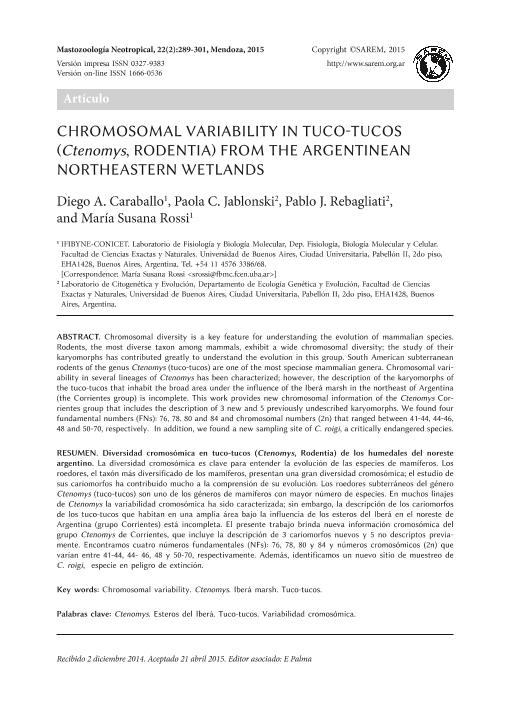Artículo
Chromosomal variability in tuco-tucos (Ctenomys, Rodentia) from the Argentinean northeastern wetlands
Fecha de publicación:
12/2015
Editorial:
Conicet. Cricyt. Instituto Argentino de Investigación de las Zonas Áridas. Unidad de Zoología y Ecología Animal
Revista:
Mastozoología Neotropical
ISSN:
0327-9383
e-ISSN:
1666-0536
Idioma:
Inglés
Tipo de recurso:
Artículo publicado
Clasificación temática:
Resumen
Chromosomal diversity is a key feature for understanding the evolution of mammalian species. Rodents, the most diversified taxon among mammals, depict a wide chromosomal diversity; the study of their karyomorphs has contributed greatly to understand the evolution in this group. South American subterranean rodents of the genus Ctenomys (tuco-tucos) are one of the most specious mammalian genera. Chromosomal variability in several lineages of Ctenomys has been characterized; however, a description of the karyomorphs concerning the tuco-tucos that inhabit the broad area under the influence of the Iberá marsh in the northeast of Argentina (the Corrientes group) is incomplete. This work provides new chromosomal information of the Ctenomys Corrientes group that includes the description of 3 new and 5 previously undescribed karyomorphs. We found four fundamental numbers (FNs): 76, 78, 80 and 84 with chromosomal numbers (2n) that ranged between 41-44, 44-46, 48 and 50-70, respectively. In addition, we found a new sampling site of C. roigi, a critically endangered species.
Palabras clave:
Chromosomal Variability
,
Ctenomys
,
Iberá Marsh
,
Tuco-Tucos
Archivos asociados
Licencia
Identificadores
Colecciones
Articulos(IFIBYNE)
Articulos de INST.DE FISIOL., BIOL.MOLECULAR Y NEUROCIENCIAS
Articulos de INST.DE FISIOL., BIOL.MOLECULAR Y NEUROCIENCIAS
Citación
Caraballo, Diego Alfredo; Jablonski, Paola Celina; Rebagliati, Pablo Javier; Rossi, Maria Susana; Chromosomal variability in tuco-tucos (Ctenomys, Rodentia) from the Argentinean northeastern wetlands; Conicet. Cricyt. Instituto Argentino de Investigación de las Zonas Áridas. Unidad de Zoología y Ecología Animal; Mastozoología Neotropical; 22; 2; 12-2015; 289-301
Compartir




